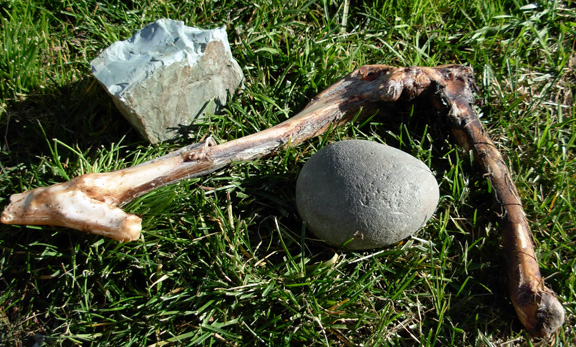
A bone awl can be manufactured with stone tools within an hour and a half of assembling your basic materials.
The same technique can be used for creating pressure flakers, knives, spear tips, arrow points, sewing needles, and hook barbs made from long bones.

1. Basic materials:
In this case the basic materials include a hind leg bone from a deer carcass. This was a tibia, but the cannon bone also works well. A piece of low grade chert was used, but any semi-knappable stone will do. You will also need a substantial hammer stone. Some smaller hammer stones come in handy later in the process as well as an abrasive surface like sandstone.
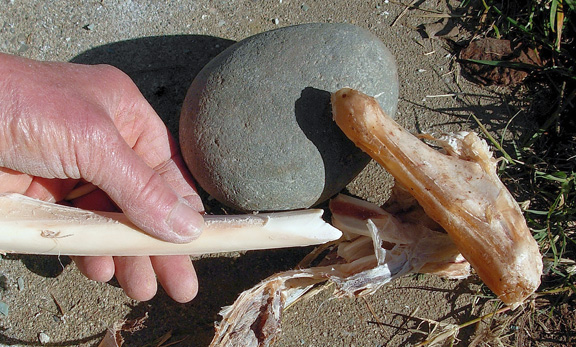
2. Crushing bone ends: (4 minutes)
The first problem is how to fracture the bone in a way that gives you a long fragment for use as an awl. Grooving a bone creates a weakness for a crack to follow. However, I have had the experience more than once when bone ends were just too massive to respond to grooving. Or I should say, too massive to groove adequately within a time frame I consider reasonable. If the bone has sufficient length, you can reduce the time needed to create an awl by crushing both bone ends before grooving.
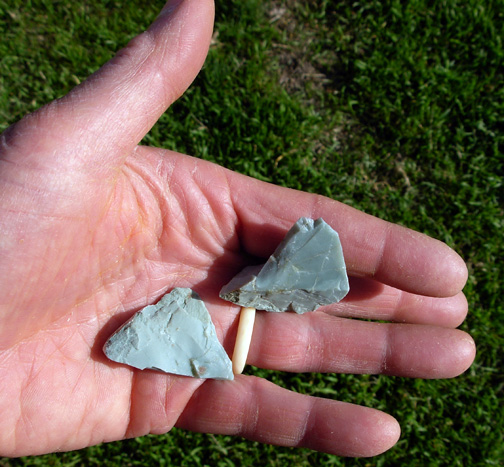
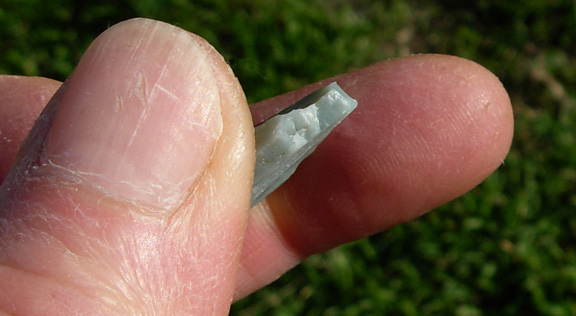
3. Create a stone burin: (2 minutes)
Use the hammer stone to strike off a few spauls from the chert or other silica rich stone you’ve found. Basalt can work too. Obsidian tends to dull quickly and to fracture in use, so a tougher stone works better. The tip of a burin spaul has an angled, chisel-like tip. Chances are, even the unpracticed hand will crack off a piece of rock with such a tip. Of course, if you are practiced in this skill, and have high quality knappable stone, you will have a far more attractive tool . . . one you may want to save. This photo just goes to show it doesn’t take much.
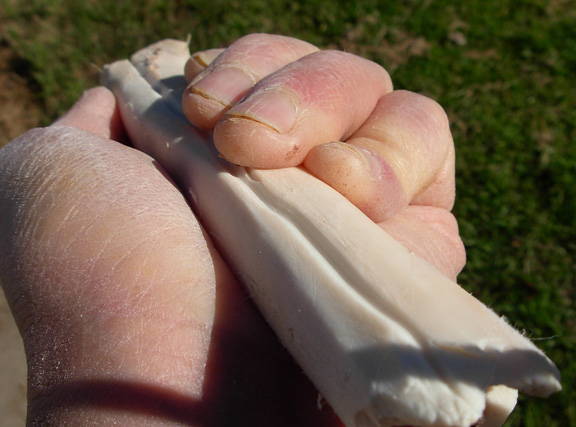
4. Creating a groove for a crack to follow: (50 minutes)
Use the burin edge to create a groove along the bone on both sides. It needs to go at least half way through the bone before you begin the split. Watch to see if the stone tool you are using is producing long shavings of bone (green, fresh bone) or substantial bone powder (cured bone). If not, change the angle of your stone tool, or choose another fragment to try. To keep the groove straight, start with a short section and extend the line as a groove forms. Once you have a track to follow, you can run the burin in longer strokes. Use a little muscle. This is by far the most time consuming and tiring part of the process. If you are strong and working with fresh bone, it may take you considerably less time.
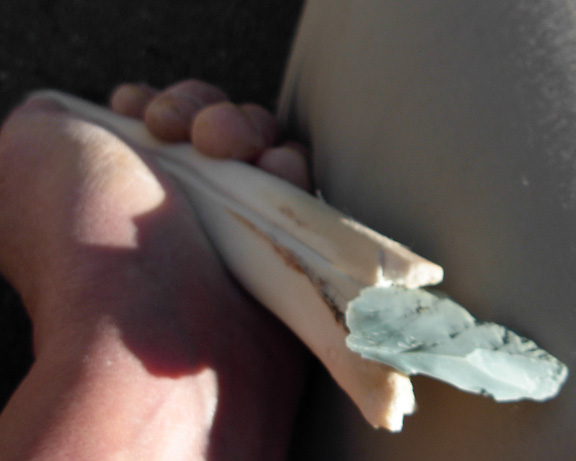
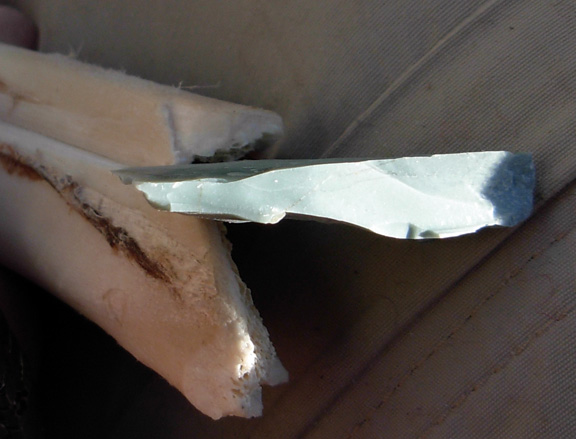
Close up of stone wedge ready to be tapped with hammer stone.
5. Use a wedge to start the crack: (1 minute)
Now select a flat section of stone to use as a wedge. Carefully tap it into the end of the bone. Stop tapping as soon as you note any cracking.
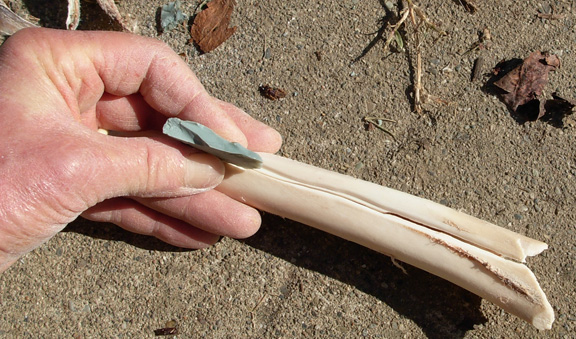
6. Extending the crack: (2 minutes)
Lay the bone down and begin using the wedge to gently extend the crack down the sides of the bone. Go slowly, turning the bone over to work the opposite side as soon as you see the crack elongate.
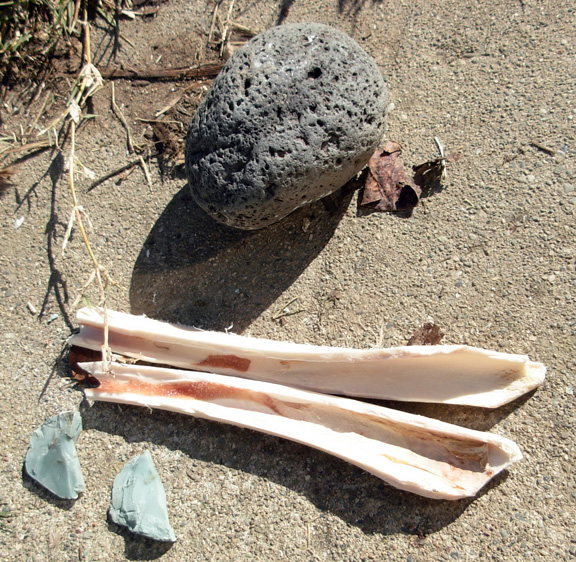
7. Completing the fracture: (1 minute)
Completed fracture should leave you with two long sections of bone.
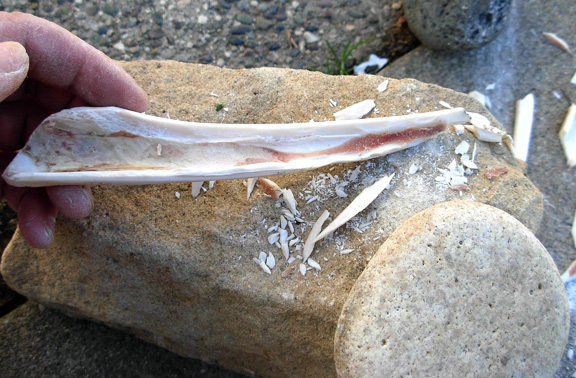
8. Rough-shaping awl point: (3 minutes)
Using a smaller stone as a hammer stone, the edge on the bone may be carefully crushed. Be sure to strike only the edge, nibbling away at it little by little. The bone must be well supported beneath the spot you are hitting. If the bone is not supported, the blow is likely to snap your awl in two.
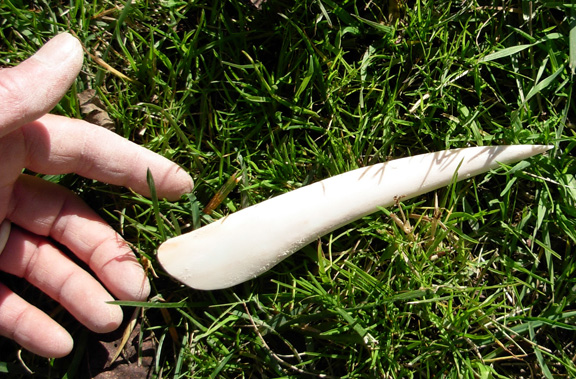
9. Grinding and shaping the awl: (10 minutes)
Rub the awl sides and tip against an abrasive surface like sandstone. Shape it so the point is strong enough and fine enough for its intended use. A leather punch requires more point and less mass than an awl used to pack down the weft of a pack basket. An awl used for a coiled basket must be quite fine and delicate.
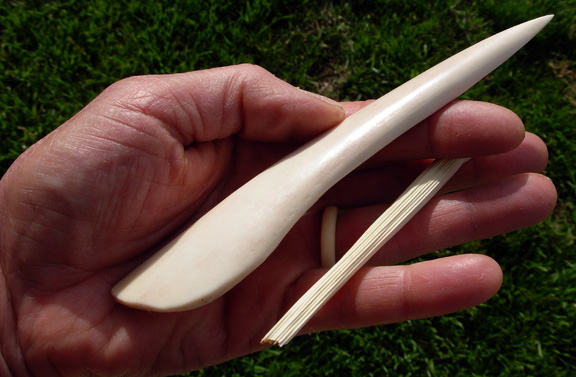
10. Polishing and honing the awl: (10 minutes)
Using a section of the plant called equisetum, the bone can be polished to a nice luster, and the tip may be honed to a fine point. This step isn’t just for looks, it actually helps the awl do its job better. A smoother tip means less resistance as it is used, and that can help avoid chipping the tip during use. Remember though, bone awls are not for prying with any force. They make holes. Once they are well into a hole, they can be used to apply lateral force, but the tip can break easily if it is used as a lever. The photo shows both the awl and the section of equisetum used to sand/polish it.
An awl like this is a handy all-purpose tool for making large holes in anything less resilient than bone. It can function as an alternative to antler if you need a pressure flaker for knapping stone points or knives. An awl can loosen dirt, split off small sections of wood from a larger piece, or pack the weft during construction of a pack basket. It could also function as a formidable weapon, or modify it with barbs to become the working end of a fishing spear.
We hope the information on the PrimitiveWays website is both instructional and enjoyable. Understand that no warranty or guarantee is included. We expect adults to act responsibly and children to be supervised by a responsible adult. If you use the information on this site to create your own projects or if you try techniques described on PrimitiveWays, behave in accordance with applicable laws, and think about the sustainability of natural resources. Using tools or techniques described on PrimitiveWays can be dangerous with exposure to heavy, sharp or pointed objects, fire, stone tools and hazards present in outdoor settings. Without proper care and caution, or if done incorrectly, there is a risk of property damage, personal injury or even death. So, be advised: Anyone using any information provided on the PrimitiveWays website assumes responsibility for using proper care and caution to protect property, the life, health and safety of himself or herself and all others. He or she expressly assumes all risk of harm or damage to all persons or property proximately caused by the use of this information.
© PrimitiveWays 2016